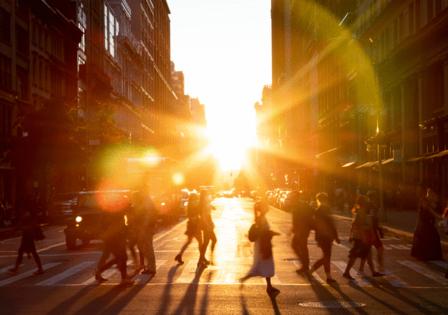Justin Fox: America wasn't made for walking, and it's killing us
Published in Op Eds
About a year and a half ago, I became one of Those People who track how many steps they walk each day. I know there’s nothing magical about the daily 10,000-step target, but it’s a fun little pastime, made more fun by the fact that I surpass 10,000 most days without really trying.
That’s because I live in Manhattan, with a dog to walk, errands to run and a commute that usually consists either of a subway ride and then a walk across Central Park, or a bike ride mostly through the park during which I occasionally go slowly enough that the steps app on my phone thinks I’m running. (It also doesn’t hurt that the nearest coffee here at Bloomberg’s New York headquarters is half a block away from my desk.)
Away from home, hitting 10,000 has proved much harder. There have been exceptions, such as visits to San Francisco and Mexico City during which I walked even more than I usually do in New York. But stays in the Vermont and California countryside, the suburbs of San Francisco and Washington, and the islands of Hawaii and Oahu all dragged down my average (10,506 steps a day since I started; 11,300 over the past year).
It’s not just me. Most Americans don’t live in places like Manhattan, and they walk a lot fewer than 10,000 steps a day. A study published in 2010 found that US adults averaged 5,117 steps daily and that this was lower than the averages found in similar studies in Switzerland, western Australia and Japan. Another study from 2017, using smartphone activity data from 111 countries and territories, found that US participants averaged 4,774 steps a day, which was below the global average of 4,961 although not by much (Hong Kong was tops at 6,880, while El Salvador came in last at 3,370).
This is definitely a lot less than people used to walk. The pre-Industrial Revolution norm has been estimated at 10,000 to 18,000 steps a day, and data from the US Census Bureau hint that Americans used to get in a lot more steps six decades ago, with the share of workers who commute primarily by walking falling sharply since 1960 (the percentage getting to work by public transportation, which often involves a lot of walking, is also way down, from 12.1% in 1960 to 3.2% in 2022).
Statistics on walking and biking to school, from the Federal Highway Administration’s National Household Travel Survey, are spottier and less reliable but also show a big decline since 1969, when 42% of schoolchildren mostly biked or walked, and a mostly flat trajectory over the past couple of decades, with 10.4% biking or walking in 2017. A comparative study published in 2020 found the US to be among the countries where kids were least likely to use “active transportation” — walking, bikes, scooters, etc. — to get to school, and that was using a different US survey that found a much higher percentage than the NHTS. (I’ve included countries with data that seemed most comparable to that of the US in the chart; there are many more in the study.)
The explanation for the decline in walking since the 1960s and Americans’ below-average international showing seems clear: It’s cars. During the second half of the 20th century, almost all new development in the US was oriented around automobiles, and the US became one of the most car-dependent countries on the planet. If you live or work or both in a place built for cars, walking more than short distances tends to be something you have to set out to do intentionally. It’s exercise, not a way of getting from point A to point B. So most people do less of it, with likely implications for obesity rates, life expectancy and other measures that have been headed in the wrong direction in the US in recent years.
A key metric tracked in that 2017 smartphone-based study of walking around the world was what the authors, a group of Stanford University computer science, engineering and medical researchers, called “activity inequality.” This measured how widely dispersed the number of daily steps was among a population, and was according to the authors “a better predictor of obesity prevalence in the population than average activity volume.” Some people will exercise a lot no matter where they are, but places where even those at the low end of the walking scale get in a respectable number of steps are likely to have better health outcomes.
The US had the fifth-highest activity inequality among 46 countries for which this was measured, behind only Saudi Arabia, Australia, Canada and Egypt (Hong Kong’s was lowest). Among US cities for which the study had data, activity inequality was highest in Arlington, Texas; Tucson, Arizona; Fort Worth, Texas; Virginia Beach, Virginia; and Cleveland; it was lowest in New York, Boston, Jersey City, Washington and San Francisco.
Over the past few decades these low-activity-inequality cities all experienced revivals, returning to growth after decades of decline. As the first chart above shows, the share of people walking or biking to work also rose slightly in the 2000s (as did the public transportation share).
The urban revival began to fizzle in the mid-2010s. One reason was simple demographics, as members of the gigantic millennial generation began to age out of their urbanophile 20s and into their more suburb-oriented 30s. But it was also that cities and walkable older suburbs failed to add much new housing even as demand revived, while communities on the fringes of metropolitan areas continued to build: 78% of US housing supply growth from 1980 to 2018 was in low-density suburbs.
Then came the Covid-19 pandemic, which temporarily shut down many of the activities that make cities attractive and brought what seems to be a permanent shift toward remote work. This has brought declines for all modes of commuting, with public transportation experiencing the steepest drop-off and the percentage declines for biking and walking roughly similar to those for cars. Big cities also lost population while the suburban fringe and some scenic rural areas and small towns gained.
Some remote workers are using the time they save by not commuting to exercise more. Transportation data provider StreetLight found, for example, that average daily biking trips in the US rose 37% from 2019 to 2022 even as bike commuting fell. But StreetLight also registered a 36% decline in average daily walking trips over that period. Overall, I would assume that the decline in commuting and the population shift from cities has resulted in Americans getting even less physical activity than they did before the pandemic, with activity inequality rising. Thanks to the arrival of weight-loss drugs Wegovy and Ozempic, this may not translate into rising obesity, but it still seems bad.
Turning around the activity decline would probably require another urban revival, which seems like a tough sell right now. When it comes to where people choose to live, I think many in the US exhibit what Marxists call false consciousness — they’ve been so brainwashed by car culture that they don’t understand they’d be healthier and happier living someplace where they didn’t always need to drive. But it’s also true that the places in the US that are most friendly to pedestrians often aren’t so friendly in other ways. Housing can be extremely expensive, the schools often underperform, there are issues with crime and public disorder. Making Americans more active and healthy may require better urban governance.
____
This column does not necessarily reflect the opinion of the editorial board or Bloomberg LP and its owners.
Justin Fox is a Bloomberg Opinion columnist covering business, economics and other topics involving charts. A former editorial director of the Harvard Business Review, he is author of “The Myth of the Rational Market.”
©2024 Bloomberg L.P. Visit bloomberg.com/opinion. Distributed by Tribune Content Agency, LLC.







Comments